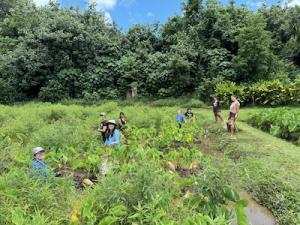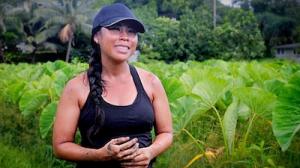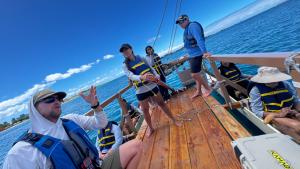UH ethnomathematics network spans the globe
VIDEO NEWS RELEASE
University of Hawaiʻi at MānoaLink to video and sound (details below): https://go.hawaii.edu/zLF
*suggested VOSOT script below*
WHO: The sixth cohort of the world’s first graduate certificate in ethnomathematics education, comprising teachers from across Hawaiʻi and the U.S. continent, recently completed a week of educational immersion activities.
They join more than 100 undergraduate STEM and pre-service educators and more than 200 P–20 public, public charter, and private school educators who are part of the UH ethnomathematics alumni network. This network map also includes partners and supporters, many of whom are based outside the U.S.
WHAT: Ethnomathematics uses real-world examples and local surroundings to prepare high-quality primary and secondary teachers as leaders through practical application of teaching and learning mathematics that bridges Indigenous wisdom and 21st century skills to classrooms and communities.
WHERE: Various Oʻahu locations including Hoʻokuaʻāina taro loʻi in Kailua.
OTHER FACTS:
In 2018, the University of Hawaiʻi at Mānoa College of Education began offering the first ethnomathematics graduate certificate and became the first academic program in ethnomathematics in the world. Later that year, the Hawaiʻi Teacher Standards Board approved ethnomathematics as a field of licensure.
There are now ethnomathematics alumni from every Hawaiʻi Department of Education complex and district across the state.
VIDEO: (TRT: 3:03)
BROLL: 2:04
:00-:28 Cohort of ethnomathematics educators at Hoʻokuaʻāina
:29-1:05 Service learning (weeding taro/kalo patch)
1:06-1:51 Measuring the contact angle of various substances with the leaf surface
1:52-2:04 Ethnomathematics educators walking through taro/kalo patches at Hoʻokuaʻāina
SOUND:
Michelle Brummel, teacher, Lahainaluna High School (:24)
“So for being from Lahaina, I really wanted to look for opportunities that would be learning opportunities that would be more meaningful and impactful for my students. And so being part of this program and being able to participate in different activities, I have seen how I can take that and apply that to my own teaching and my own classroom.”
Linda Furuto, professor, UH Mānoa (describes what the teachers did at Hoʻokuaʻāina) (:21)
“Our students found different connections to their land or their homes or their schools or communities. And then we had conversations when we met the next time about how kalo hydrophobicity and angles of elevation and declination and geometry and algebra were connected to our natural environment.”
Mary Mares, high school STEM teacher, Colorado (:14)
“I think I've seen this model of learning about our students and sharing what we know and letting them share what they know so that they can see themselves in the math.”
*VOSOT SCRIPT*
INTRO:
The latest group of teachers to participate in the University of Hawaiʻi at Mānoa’s first-in-the-world ethnomathematics academic program recently did a session in a taro loʻi.
VO:
Teachers from across Hawaiʻi and the U.S. did service learning at Hoʻokuaʻāina cultural center? in Kailua and related their experiences to math.
SOT:
Linda Furuto, professor, UH Mānoa
“Our students found different connections to their land or their homes or their schools or communities. And then we had conversations when we met the next time about how kalo hydrophobicity and angles of elevation and declination and geometry and algebra were connected to our natural environment.”
Michelle Brummel, teacher, Lahainaluna High School
“So for being from Lahaina, I really wanted to look for opportunities that would be learning opportunities that would be more meaningful and impactful for my students. And so being part of this program and being able to participate in different activities, I have seen how I can take that and apply that to my own teaching and my own classroom.”
VO:
Brummel and her fellow teachers join more than 100 undergraduate STEM and pre-service educators and more than 200 P–20 educators who are part of the UH’s global ethnomathematics network.





